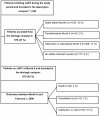Impact of drug stock-outs on death and retention to care among HIV-infected patients on combination antiretroviral therapy in Abidjan, Côte d'Ivoire
- PMID: 20976211
- PMCID: PMC2955519
- DOI: 10.1371/journal.pone.0013414
Impact of drug stock-outs on death and retention to care among HIV-infected patients on combination antiretroviral therapy in Abidjan, Côte d'Ivoire
Abstract
Background: To evaluate the type and frequency of antiretroviral drug stock-outs, and their impact on death and interruption in care among HIV-infected patients in Abidjan, Côte d'Ivoire.
Methods and findings: We conducted a cohort study of patients who initiated combination antiretroviral therapy (cART) in three adult HIV clinics between February 1, 2006 and June 1, 2007. Follow-up ended on February 1, 2008. The primary outcome was cART regimen modification, defined as at least one drug substitution, or discontinuation for at least one month due to drug stock-outs at the clinic pharmacy. The secondary outcome for patients who were on cART for at least six months was interruption in care, or death. A Cox regression model with time-dependent variables was used to assess the impact of antiretroviral drug stock-outs on interruption in care or death. Overall, 1,554 adults initiated cART and were followed for a mean of 13.2 months. During this time, 72 patients discontinued treatment and 98 modified their regimen because of drug stock-outs. Stock-outs involved nevirapine and fixed-dose combination zidovudine/lamivudine in 27% and 51% of cases. Of 1,554 patients, 839 (54%) initiated cART with fixed-dose stavudine/lamivudine/nevirapine and did not face stock-outs during the study period. Among the 975 patients who were on cART for at least six months, stock-out-related cART discontinuations increased the risk of interruption in care or death (adjusted hazard ratio [HR], 2.83; 95%CI, 1.25-6.44) but cART modifications did not (adjusted HR, 1.21; 95%CI, 0.46-3.16).
Conclusions: cART stock-outs affected at least 11% of population on treatment. Treatment discontinuations due to stock-outs were frequent and doubled the risk of interruption in care or death. These stock-outs did not involve the most common first-line regimen. As access to cART continues to increase in sub-Saharan Africa, first-line regimens should be standardized to decrease the probability of drug stock-outs.
Conflict of interest statement
Figures


References
-
- UNAIDS/WHO. Report on the global AIDS epidemic. Geneva: 2008.
-
- News in brief. US Senate approves AIDS bill. Lancet. 2003;361:1799. - PubMed
-
- WHO/UNAIDS/UNICEF. Towards Universal Acces. 2007. Scaling up priority HIV/AIDS interventions in the health sector. Progress report.
-
- Fischer A, Karasi JC, Kibibi D, Omes C, Lambert C, et al. Antiviral efficacy and resistance in patients on antiretroviral therapy in Kigali, Rwanda: the real-life situation in 2002. HIV Med. 2006;7:64–66. - PubMed
Publication types
MeSH terms
Substances
Grants and funding
LinkOut - more resources
Full Text Sources
Medical
Research Materials

